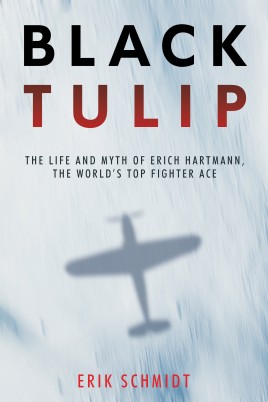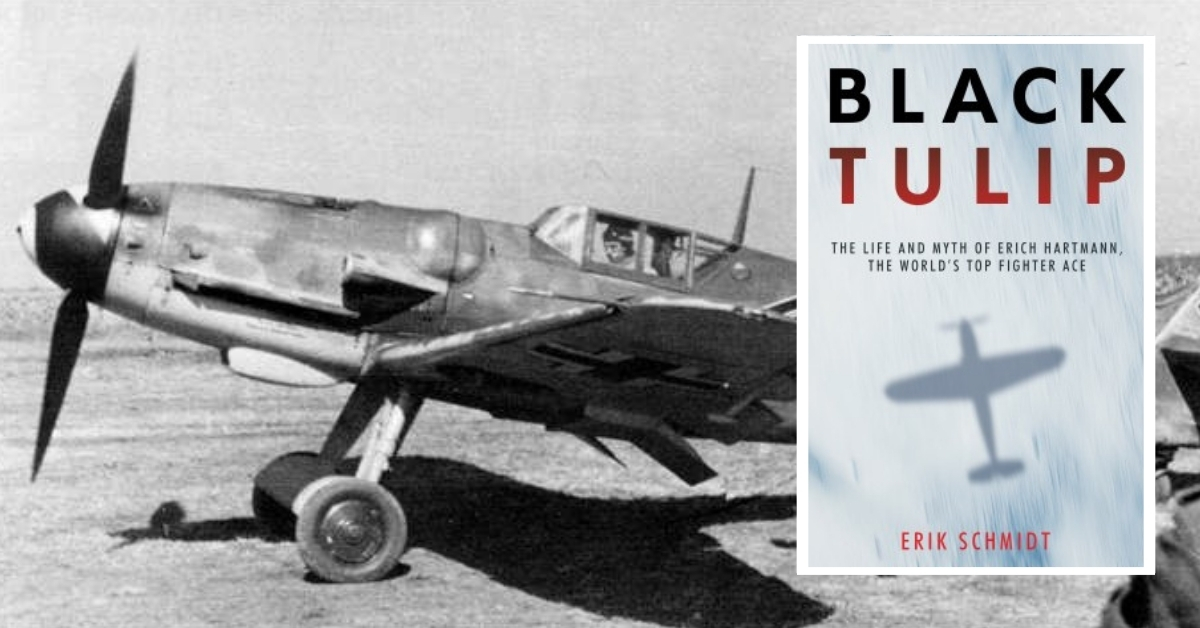Biographies of well-known fighter aces often take on a standard formula whereby the spine of the story is filled with tails of mortal combat, the tumult in the clouds, where the chief protagonist achieves his fame. There is some room for early life and family background. If our hero lives out the conflict under discussion we will find his attempt to adjust to peacetime living and there will be reflections on the past. The end.
This book by Erik Schmidt does and doesn’t follow the formula, mainly because the subject, the life and legacy of Erich Hartmann, doesn’t really allow for it. The author must have started his project hoping to find a route to the truth of Hartmann, his deeper meaning within the context of Nazi Germany during World War II and the post war creation of West Germany. Our author is not ashamed to suggest he may never have got even close to the heart of the man.
What we have here is something deeper, way more cerebral than the off the peg life of a fighter jock type book I would still have enjoyed. The author takes us on a broader and yet more focussed path by attempting to fix Hartmann into his place in history and the events of his life. He hopes to give us something more tangible of the man rather than a procession of derring-do moments of diving out of the sun onto the tail of an unfortunate YaK or MiG.
He starts by looking at Hartmann’s young life in China and how, on his return to Germany, he was subsumed into the morose nature of the Nazi education system. It didn’t want individualists and thinkers, it created a workforce, for the factories, for the mines, for the military. All the self-sufficiency the boy Hartmann picked up in China and the long journey home were beaten out of him at school. But this did not stop him becoming an exceptional fighter pilot.
Ok, it isn’t a spoiler if I tell you this is not a book for exhaustive coverage of Hartmann’s remarkable tally of three hundred and fifty two victories. Instead the book takes us through the more abstract nature of his experiences. Hartmann never really had a great deal to say about his life in the hot seat and, in fact, he chose to say very little about his life at all, even though there have been earlier works on his career. Having not read any of them I can only assume they follow my formula from the opening paragraph of this review.
Mister Schmidt is more interested in Hartmann’s attitude to Nazism and his understanding of the stark truth about Germany’s war of conquest and brutalisation of its neighbours. What did Hartmann know about the death camps and what the Einsatzgruppen were doing? Here, as ever, the net return is opaque.
There are details. We see Hartmann visiting Hitler to receive the higher stages of the Knight’s Cross. He arrives drunk, refuses to surrender his pistol and puts on the Führer’s hat by mistake. He offers Hitler a free and frank assessment of how the war is going. Perhaps only a fighter ace with an enormous score of kills could do this.
There are notes on some of those victories as the tally mounts up. Perhaps the most significant is the last of them, a fighter he shot down on his final combat mission in May 1945. Hartmann lost most of his original logs when captured by the Americans, but with or without them he doesn’t seem keen to remember any of it, much less talk about it with strangers.
For me the most intriguing part of the book concerns Hartmann’s time in labour camps after being handed over to the Soviets by the Americans. The interrogations and threats fulfil all we assume of what life was like for man like Hartmann. We learn about the conditions, his almost skeletal self, but also his strong sense of defiance. The Soviet system was bloated, lazy and incompetent. Hartmann led a mutiny in one camp and appears to have earned the grudging respect of some of his guards. He survived a decade in captivity.
New life followed. Hartmann came home and rebuilt his life and marriage. He was devoted to his wife Ursula and their relationship offers us the most human element of the book. He joined the post war Luftwaffe where his status as a great ace did not always work in his favour.
Hartmann’s sense of individuality was as out of step with the new Germany just as much as it had been with the old. He flew Sabre fighters and adorned them with his black tulip markings; something his superiors did not like.
Hartmann clashed with senior officers over a lot of things, but chief of them was his objection to the adoption of the Lockheed Starfighter, an aircraft he believed the Luftwaffe was not ready for. The author reminds us about the notorious sales methods of Lockheed at that time and the strong whiff of corruption is never far away. Planes crash and pilots die. There were no more promotions for Erich Hartmann. He had come up against a labyrinthine politicised machine and lost.
At the end there is little to say of his unremarkable death and passing. The author visits his grave and seeks an assessment of Hartmann from the townspeople who knew of him. Things remain just as vague. The author tries to place our hero in the post war world alongside those other Luftwaffe greats, Heinz Rudel and Adolf Galland. While we know Rudel never lost his enthusiasm for the Nazi cause, Galland’s position is much more nuanced.
The author uses them to assess where Hartmann might be placed in the absence of any true understanding of the man himself. Here again any adulation for the bravery and brilliance of Rudel and Galland has to be balanced with knowledge of what they were fighting for.
Erich Hartmann remains an enigma. Visiting his grave saw the author as close to the man as he was ever likely to get. This is a genuinely fascinating and often compelling book. I like Erik Schmidt’s honesty and his attention to detail. He really wants to know Hartmann and to share all he has learned with us. But he is left disappointed, I’m sure, because by accident or design the man himself refused to play ball in life and in death.
This is a man who shot down three hundred and fifty two aircraft, where on some occasions he did that ten times in a single day. The author reminds us of Hartmann’s near continuous combat flying and how at the rate of one victory a day he would have been an ace with a prodigious record. But Hartmann was more than that. He was exceptional.
Erich Hartmann, that hard to pin down guy who seems to have been both contrary and yet intensely focussed, was made to be a fighter pilot and being a fighter pilot made him… but not entirely. There is so much we will never know about the highest scoring fighter ace in history. This book will give you much, perhaps more than you expected, but it can never present the complete story and the author is the first to admit it. Fascinating stuff.
Reviewed by Mark Barnes for War History Online

BLACK TULIP
The Life and Myth of Erich Hartmann, the World’s Top Fighter Ace
By Erik Schmidt
Casemate Publishers
ISBN: 978 1 61200 824 0
